Mechanisms of Sulfate In Situ Removal Using SRB-PRB Driven by Low-Cost Sustained-Release Carbon Source in Coal Mine Goafs: A Dynamic Column Experiment Study
Abstract
1. Introduction
2. Materials and Methods
2.1. Materials
2.1.1. Inoculum
2.1.2. Adsorbents Packed in PRB
2.1.3. Low-Cost and Slow-Release Carbon Source Packed in PRB
2.2. Construction of the SRB-PRB Column Experiments
2.2.1. Simulated Mine Water
2.2.2. Design of Column Experiments
2.3. Operation of the SRB-PRB Column Experiments
2.3.1. Microbial Biofilm Colonization Startup Experiment for SRB-PRB Columns
2.3.2. Continuous Operation of SRB-PRB Column Experiments
2.3.3. Analysis of the Sulfate Removal Mechanism for SRB-PRB Column Experiments
3. Results and Discussion
3.1. Performance of SRB-PRB Column Experiments Operation
3.1.1. Hydrochemical Evolution Characteristics During Biofilm Colonization in SRB-PRB Columns
3.1.2. pH Variation During Continuous Operation
3.1.3. ORP Variation During Continuous Operation
3.1.4. SO42− Variation During Continuous Operation
3.2. DOM Variation Characteristics
3.2.1. Variation Trend of DOM in the Effluent During Operation
3.2.2. Comparison of DOM Compositions Leached from the Corncobs Before and After Experiments
3.3. Microscopic Mechanism of SO42− Reductive Removal by SRB
3.3.1. Microbial Community Variation Mechanism
3.3.2. Organic Functional Groups Variation in Corncobs
3.3.3. Morphology and Elemental Composition Variation in the Fillers
4. Application Prospect of SRB-PRB for In Situ Treatment in Coal Mine Goaf
5. Conclusions
- (1)
- Two SRB-PRB columns (1# mixed packed column and #2 layered packed column) were constructed. After 3 d of biofilm colonization, the sulfate removal efficiency reached 85%, indicating successful biofilm establishment. During the 40 d operation, the pH variation could be divided into a rapid decrease stage (0–10 d) and a slow increase stage (10–40 d), with a more significant pH decrease observed in the mixed packed column. The ORP variation showed the following trend: first rapidly decreasing, then rising slowly, and finally stabilizing. Eventually, ORP stabilized at ~−120 mV in the mixed packed column, and ~−100 mV in the layered packed column, both sustaining a strong reducing environment. According to the variation trend of SO42− removal efficiency, the experiment process was divided into three stages: rapid reduction (0–6 d), stable reduction (6–16 d), and reduction attenuation (16–40 d). Corncob could provide a relatively long-term carbon source supply, with the maximum average removal efficiency of 65.5% for the mixed packed column and 56.6% for the layered packed column.
- (2)
- The DOM in the effluents of both the mixed packed column and the layered packed column mainly consisted of tyrosine-like (I zone), tryptophan-like (II zone), and soluble microbial products (IV zone), which served as the main carbon sources for SRB. A large number of complex organic-degrading bacteria were detected in both the effluent water samples and the solid packed media, while SRB became dominant only in the solid packed media, with the relative abundances in 1# and 2# being merely 7.05% and 5.12%, respectively. However, the low-abundance SRB could still maintain a high-efficiency sulfate reduction. This process was closely related to the supply of readily utilizable carbon sources provided by hydrolytic and fermentative bacteria. This study confirmed the existence of a synergistic effect between SRB and these organic-degrading bacteria.
- (3)
- The SEM results of corncob and zeolite showed that the structures of both were damaged with fine mineral deposits, and EDS indicated that Fe and S were enriched on the surfaces of zeolite and corncobs in the mixed packed column. FTIR results revealed that the absorption intensity of functional groups in corncobs decreased after the reaction, with their structures damaged, and this phenomenon was more obvious in the corncob from the mixed packed column. All the above microscopic characterizations confirm that sulfate reduction of SO42− occurred in the SRB-PRB column.
- (4)
- Engineering applicability was evaluated based on 3103 goaf in the MKQ coal mine. The engineering application schemes of SRB-PRB under both in-production and abandoned mining scenarios were proposed. Additionally, a material cost estimate was carried out, and the results showed that SRB-PRB could achieve in situ and low-cost remediation (0.2–1.55 USD/m3) of the characteristic pollutant SO42−.
Supplementary Materials
Author Contributions
Funding
Data Availability Statement
Acknowledgments
Conflicts of Interest
References
- Gu, D.; Li, J.; Cao, Z.; Wu, B.; Jiang, B.; Yang, Y.; Yang, J.; Chen, Y. Technology and engineering development strategy of water protection and utilization of coal mine in China. J. China Coal Soc. 2021, 46, 3079–3089. [Google Scholar] [CrossRef]
- Sun, Y.; Guo, J.; Xu, Z.; Zhang, L.; Chen, G.; Xiong, X.; Hua, J.; Mu, L.; Wu, W. Spatial distribution characteristics of mine water quality in coal mining areas of China and technological approaches for mine water treatment. J. China Coal Soc. 2025, 50, 584–599. [Google Scholar] [CrossRef]
- Li, X.; Ren, H.; Xu, Z.; Chen, G.; Zhang, S.; Zhang, L.; Sun, Y. Practical application for legacy acid mine drainage (AMD) prevention and treatment technologies in karst-dominated regions: A case study. J. Contam. Hydrol. 2023, 258, 104238. [Google Scholar] [CrossRef] [PubMed]
- Chen, H.; Chen, H.; Zhang, F.; Han, Z.; Shi, H.; Meng, J.; Feng, Q.; Chen, D. Study on the Impact of Closed Coal Mines on Groundwater in the Panlong River Basin (Shangdong Province, China) Based on Sulfur and Oxygen Isotopes. Water 2024, 16, 1634. [Google Scholar] [CrossRef]
- Banks, D.; Boyce, A.J.; Burnside, N.M.; Janson, E.; Roqueñi Gutierrez, N. On the common occurrence of sulphate with elevated δ34S in European mine waters: Sulphides, evaporites or seawater? Int. J. Coal Geol. 2020, 232, 103619. [Google Scholar] [CrossRef]
- Sun, W.; Ren, S.; Wu, Q.; Dong, D.; Gan, X. Waterpollution’s prevention and comprehensive utilization of abandoned coal mines in China under the new normal life. J. China Coal Soc. 2022, 47, 2161–2169. [Google Scholar] [CrossRef]
- Mosai, A.K.; Ndlovu, G.; Tutu, H. Improving acid mine drainage treatment by combining treatment technologies: A review. Sci. Total Environ. 2024, 919, 170806. [Google Scholar] [CrossRef]
- Hu, Y.; Jiang, B.; Zhang, H.; Li, J.; He, A.; Hao, J. Progress and optimization strategies for the application of sulfate reducing bacteria in mine water treatment. J. China Coal Soc. 2025, 50, 1–16. [Google Scholar] [CrossRef]
- Wang, Z.; Xu, Y.; Zhang, Z.; Zhang, Y. Review: Acid Mine Drainage (AMD) in Abandoned Coal Mines of Shanxi, China. Water 2021, 13, 8. [Google Scholar] [CrossRef]
- Virpiranta, H.; Sotaniemi, V.; Leiviskä, T.; Taskila, S.; Rämö, J.; Johnson, D.B.; Tanskanen, J. Continuous removal of sulfate and metals from acidic mining-impacted waters at low temperature using a sulfate-reducing bacterial consortium. Chem. Eng. J. 2022, 427, 132050. [Google Scholar] [CrossRef]
- Ayangbenro, A.S.; Olanrewaju, O.S.; Babalola, O.O. Sulfate-Reducing Bacteria as an Effective Tool for Sustainable Acid Mine Bioremediation. Front. Microbiol. 2018, 9, 1986. [Google Scholar] [CrossRef] [PubMed]
- Hwang, S.K.; Jho, E.H. Heavy metal and sulfate removal from sulfate-rich synthetic mine drainages using sulfate reducing bacteria. Sci. Total Environ. 2018, 635, 1308–1316. [Google Scholar] [CrossRef] [PubMed]
- Oyama, K.; Hayashi, K.; Masaki, Y.; Hamai, T.; Fuchida, S.; Takaya, Y.; Tokoro, C. Geochemical Modeling of Heavy Metal Removal from Acid Mine Drainage in an Ethanol-Supplemented Sulfate-Reducing Column Test. Materials 2023, 16, 928. [Google Scholar] [CrossRef] [PubMed]
- Miranda, E.M.; Severson, C.; Reep, J.K.; Hood, D.; Hansen, S.; Santisteban, L.; Hamdan, N.; Delgado, A.G. Continuous-mode acclimation and operation of lignocellulosic sulfate-reducing bioreactors for enhanced metal immobilization from acidic mining-influenced water. J. Hazard. Mater. 2022, 425, 128054. [Google Scholar] [CrossRef]
- Marques, J.P.; Rodrigues, V.G.S. A Systematic Literature Review of Treatment Approaches with Sulfate-Reducing Bacteria for Acid Mine Drainage. Water Air Soil Pollut. 2025, 236, 271. [Google Scholar] [CrossRef]
- Logan, M.V.; Reardon, K.F.; Figueroa, L.A.; Mclain, J.E.T.; Ahmann, D.M. Microbial community activities during establishment, performance, and decline of bench-scale passive treatment systems for mine drainage. Water Res. 2005, 39, 4537–4551. [Google Scholar] [CrossRef]
- Gibert, O.; de Pablo, J.; Luis Cortina, J.; Ayora, C. Chemical characterisation of natural organic substrates for biological mitigation of acid mine drainage. Water Res. 2004, 38, 4186–4196. [Google Scholar] [CrossRef]
- Magowo, W.E.; Sheridan, C.; Rumbold, K. Global Co-occurrence of Acid Mine Drainage and Organic Rich Industrial and Domestic Effluent: Biological sulfate reduction as a co-treatment-option. J. Water Process. Eng. 2020, 38, 101650. [Google Scholar] [CrossRef]
- Sato, Y.; Hamai, T.; Hori, T.; Habe, H.; Kobayashi, M.; Sakata, T. Year-Round Performance of a Passive Sulfate-Reducing Bioreactor that Uses Rice Bran as an Organic Carbon Source to Treat Acid Mine Drainage. Mine Water Environ. 2018, 37, 586–594. [Google Scholar] [CrossRef]
- Rodrigues, C.; Núñez-Gómez, D.; Silveira, D.D.; Lapolli, F.R.; Lobo-Recio, M.A. Chitin as a substrate for the biostimulation of sulfate-reducing bacteria in the treatment of mine-impacted water (MIW). J. Hazard. Mater. 2019, 375, 330–338. [Google Scholar] [CrossRef]
- Dovorogwa, H.; Harding, K. Exploring the Use of Tobacco Waste as a Metal Ion Adsorbent and Substrate for Sulphate-Reducing Bacteria during the Treatment of Acid Mine Drainage. Sustainability 2022, 14, 14333. [Google Scholar] [CrossRef]
- Di, J.; Ma, Y.; Wang, M.; Gao, Z.; Xu, X.; Dong, Y.; Fu, S.; Li, H. Dynamic experiments of acid mine drainage with Rhodopseudomonas spheroides activated lignite immobilized sulfate-reducing bacteria particles treatment. Sci. Rep. 2022, 12, 8783. [Google Scholar] [CrossRef]
- Xu, Z.; Zhang, L.; Gao, Y.; Tan, X.; Sun, Y.; Chen, W. Effects of Coal Mining Activities on the Changes in Microbial Community and Geochemical Characteristics in Different Functional Zones of a Deep Underground Coal Mine. Water 2024, 16, 1836. [Google Scholar] [CrossRef]
- Zhang, L.; Xu, Z.; Sun, Y.; Gao, Y.; Zhu, L. Coal Mining Activities Driving the Changes in Microbial Community and Hydrochemical Characteristics of Underground Mine Water. Int. J. Environ. Res. Public Health 2022, 19, 13359. [Google Scholar] [CrossRef]
- Chen, W.; Westerhoff, P.; Leenheer, J.A.; Booksh, K. Fluorescence Excitation−Emission Matrix Regional Integration to Quantify Spectra for Dissolved Organic Matter. Environ. Sci. Technol. 2003, 37, 5701–5710. [Google Scholar] [CrossRef] [PubMed]
- Qin, X.; Yao, B.; Jin, L.; Zheng, X.; Ma, J.; Benedetti, M.F.; Li, Y.; Ren, Z. Characterizing Soil Dissolved Organic Matter in Typical Soils from China Using Fluorescence EEM–PARAFAC and UV–Visible Absorption. Aquat. Geochem. 2020, 26, 71–88. [Google Scholar] [CrossRef]
- Taubert, M.; Overholt, W.A.; Heinze, B.M.; Matanfack, G.A.; Houhou, R.; Jehmlich, N.; von Bergen, M.; Rösch, P.; Popp, J.; Küsel, K. Bolstering fitness via CO2 fixation and organic carbon uptake: Mixotrophs in modern groundwater. ISME J. 2022, 16, 1153–1162. [Google Scholar] [CrossRef]
- Yang, Y.; Abdelfattah, A.; Jia, H.; Kumar, V.; Jiang, Y.; Cheng, L. Enhanced nitrogen removal by Comamonas 110 colonization and bioaugmentation in sequencing batch activated sludge bioreactor. Bioresour. Technol. 2025, 433, 132759. [Google Scholar] [CrossRef] [PubMed]
- Wu, Y.; Zaiden, N.; Cao, B. The Core- and Pan-Genomic Analyses of the Genus Comamonas: From Environmental Adaptation to Potential Virulence. Front. Microbiol. 2018, 9, 3096. [Google Scholar] [CrossRef]
- Silva, I.; Tacão, M.; Henriques, I. Hidden threats in the plastisphere: Carbapenemase-producing Enterobacterales colonizing microplastics in river water. Sci. Total Environ. 2024, 922, 171268. [Google Scholar] [CrossRef]
- Xiao, X.; Li, C.; Peng, J.; Fan, Y.; Li, W. Dynamic roles of inner membrane electron-transfer hub of Shewanella oneidensis MR-1 in response to extracellular reduction kinetics. Chem. Eng. J. 2023, 451, 138717. [Google Scholar] [CrossRef]
- Tao, X.; Morgan, J.S.; Liu, J.; Kempher, M.L.; Xu, T.; Zhou, J. Target integration of an exogenous β-glucosidase enhances cellulose degradation and ethanol production in Clostridium cellulolyticum. Bioresour. Technol. 2023, 376, 128849. [Google Scholar] [CrossRef] [PubMed]
- Mcdonald, J.E.; Houghton, J.N.I.; Rooks, D.J.; Allison, H.E.; Mccarthy, A.J. The microbial ecology of anaerobic cellulose degradation in municipal waste landfill sites: Evidence of a role for fibrobacters. Environ. Microbiol. 2012, 14, 1077–1087. [Google Scholar] [CrossRef] [PubMed]
- Hirano, K.; Kurosaki, M.; Nihei, S.; Hasegawa, H.; Shinoda, S.; Haruki, M.; Hirano, N. Enzymatic diversity of the Clostridium thermocellum cellulosome is crucial for the degradation of crystalline cellulose and plant biomass. Sci. Rep. 2016, 6, 35709. [Google Scholar] [CrossRef]
- Wang, X.; Shen, S.; Wu, H.; Wang, H.; Wang, L.; Lu, Z. Acinetobacter tandoii ZM06 Assists Glutamicibacter nicotianae ZM05 in Resisting Cadmium Pressure to Preserve Dipropyl Phthalate Biodegradation. Microorganisms 2021, 9, 1417. [Google Scholar] [CrossRef]
- Shao, Y.; Wang, Y.; Wu, X.; Xu, X.; Kong, S.; Tong, L.; Jiang, Z.; Li, B. Biodegradation of PAHs by Acinetobacter isolated from karst groundwater in a coal-mining area. Environ. Earth Sci. 2015, 73, 7479–7488. [Google Scholar] [CrossRef]
- Cui, J.; Chen, H.; Sun, M.; Wen, J. Comparison of bacterial community structure and function under different petroleum hydrocarbon degradation conditions. Bioprocess Biosyst. Eng. 2020, 43, 303–313. [Google Scholar] [CrossRef]
- El-Messiry, H.M.; Hamdan, A.M.; Ghanem, N.B.; Hagar, M. Exopolysaccharide produced from Lactiplantibacillus plantarum HAN99 and its nanoparticle formulations in agricultural applications. Sci. Rep. 2025, 15, 19188. [Google Scholar] [CrossRef]
- Deng, Y.; Wang, S.Y. Sorption of Cellulases in Biofilm Enhances Cellulose Degradation by Bacillus subtilis. Microorganisms 2022, 10, 1505. [Google Scholar] [CrossRef]
- Bian, X.; Miao, W.; Zhao, M.; Zhao, Y.; Xiao, Y.; Li, N.; Wu, J. Microbiota drive insoluble polysaccharides utilization via microbiome-metabolome interplay during Pu-erh tea fermentation. Food Chem. 2022, 377, 132007. [Google Scholar] [CrossRef]
- Maharaja, P.; Boopathy, R.; Anushree, V.V.; Mahesh, M.; Swarnalatha, S.; Ravindran, B.; Chang, S.W.; Sekaran, G. Bio removal of proteins, lipids and mucopolysaccharides in tannery hyper saline wastewater using halophilic bacteria. J. Water Process. Eng. 2020, 38, 101674. [Google Scholar] [CrossRef]
- Dong, W.; Zhou, R.; Li, X.; Yan, H.; Zheng, J.; Peng, N.; Zhao, S. Effect of simplified inoculum agent on performance and microbiome during cow manure-composting at industrial-scale. Bioresour. Technol. 2024, 393, 130097. [Google Scholar] [CrossRef]
- Cherian, T.; Maity, D.; Rajendra Kumar, R.T.; Balasubramani, G.; Ragavendran, C.; Yalla, S.; Mohanraju, R.; Peijnenburg, W.J.G.M. Green Chemistry Based Gold Nanoparticles Synthesis Using the Marine Bacterium Lysinibacillus odysseyi PBCW2 and Their Multitudinous Activities. Nanomaterials 2022, 12, 2940. [Google Scholar] [CrossRef]
- Walter, A.; Sopracolle, L.; Mutschlechner, M.; Spruck, M.; Griesbeck, C. Biodegradation of different PET variants from food containers by Ideonella sakaiensis. Arch. Microbiol. 2022, 204, 711. [Google Scholar] [CrossRef]
- Tanasupawat, S.; Takehana, T.; Yoshida, S.; Hiraga, K.; Oda, K. Ideonella sakaiensis sp. nov., isolated from a microbial consortium that degrades poly(ethylene terephthalate). Int. J. Syst. Evol. Microbiol. 2016, 66, 2813–2818. [Google Scholar] [CrossRef]
- Gao, P.; Sun, X.; Xiao, E.; Xu, Z.; Li, B.; Sun, W. Characterization of iron-metabolizing communities in soils contaminated by acid mine drainage from an abandoned coal mine in Southwest China. Environ. Sci. Pollut. Res. 2019, 26, 9585–9598. [Google Scholar] [CrossRef]
- Sato, Y.; Hamai, T.; Hori, T.; Aoyagi, T.; Inaba, T.; Kobayashi, M.; Habe, H.; Sakata, T. Desulfosporosinus spp. were the most predominant sulfate-reducing bacteria in pilot- and laboratory-scale passive bioreactors for acid mine drainage treatment. Appl. Microbiol. Biotechnol. 2019, 103, 7783–7793. [Google Scholar] [CrossRef] [PubMed]
- Mirjafari, P.; Baldwin, S.A. Decline in Performance of Biochemical Reactors for Sulphate Removal from Mine-Influenced Water is Accompanied by Changes in Organic Matter Characteristics and Microbial Population Composition. Water 2016, 8, 124. [Google Scholar] [CrossRef]
- Rodrigues, C.; Núñez-Gómez, D.; Follmann, H.V.D.M.; Silveira, D.D.; Nagel-Hassemer, M.E.; Lapolli, F.R.; Lobo-Recio, M.Á. Biostimulation of sulfate-reducing bacteria and metallic ions removal from coal mine-impacted water (MIW) using shrimp shell as treatment agent. J. Hazard. Mater. 2020, 398, 122893. [Google Scholar] [CrossRef] [PubMed]
- Kostryukov, S.G.; Matyakubov, H.B.; Masterova, Y.Y.; Kozlov, A.S.; Pryanichnikova, M.K.; Pynenkov, A.A.; Khluchina, N.A. Determination of Lignin, Cellulose, and Hemicellulose in Plant Materials by FTIR Spectroscopy. J. Anal. Chem. 2023, 78, 718–727. [Google Scholar] [CrossRef]
- GB/T 14848-2017; Standard for Groundwater Quality. Standards Press of China: Beijing, China, 2017.
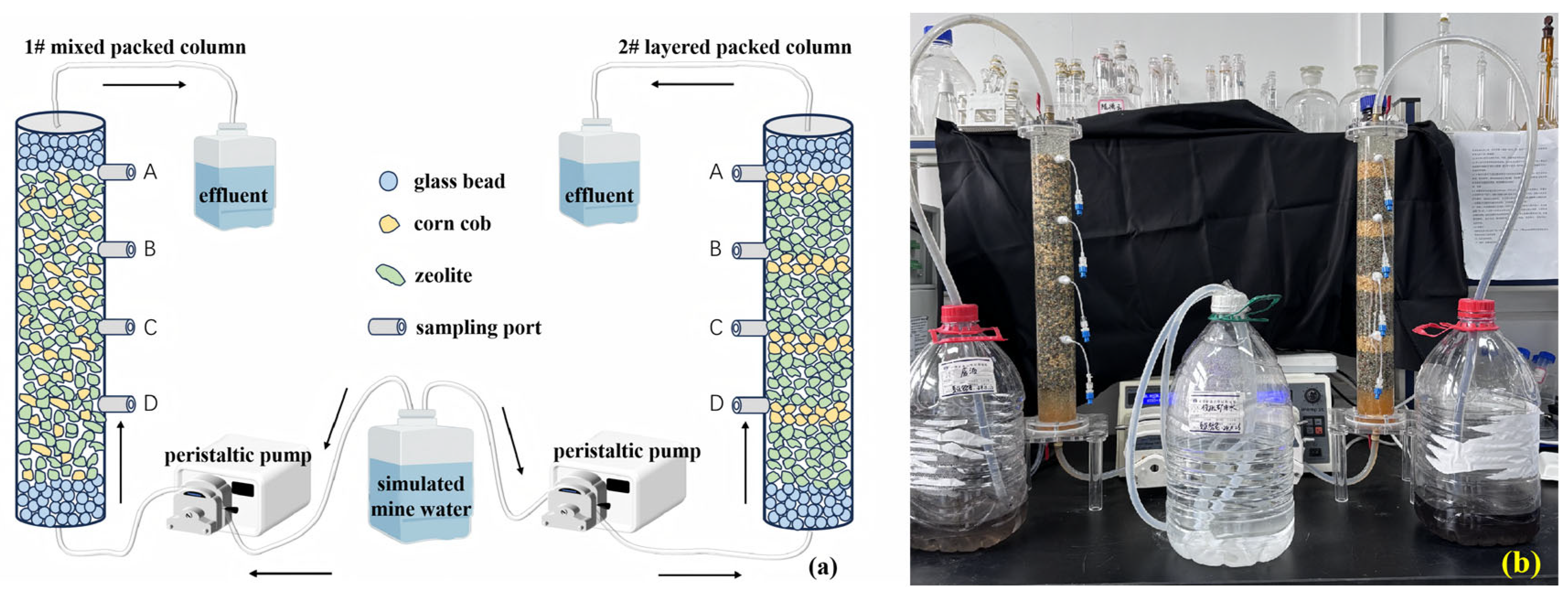
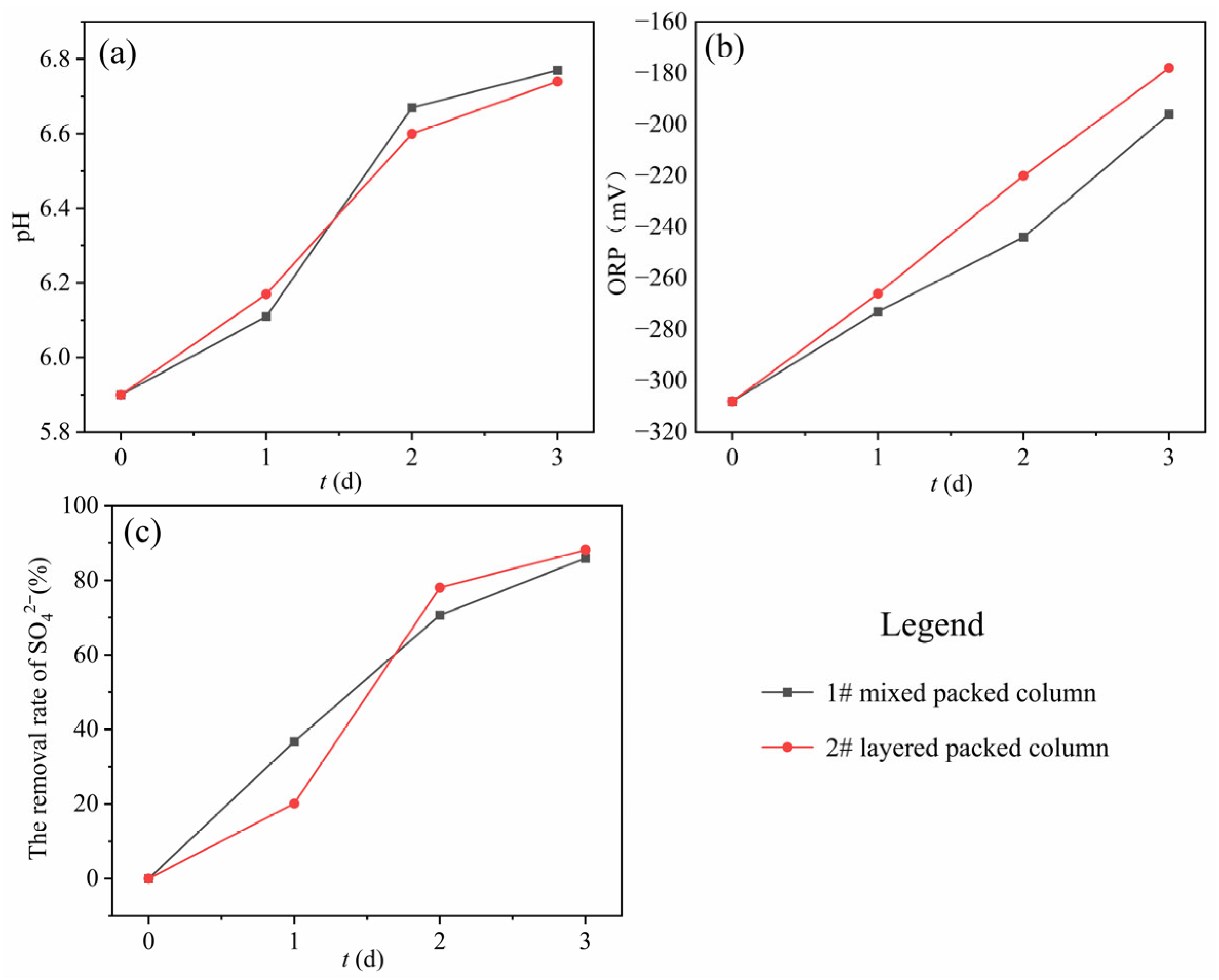
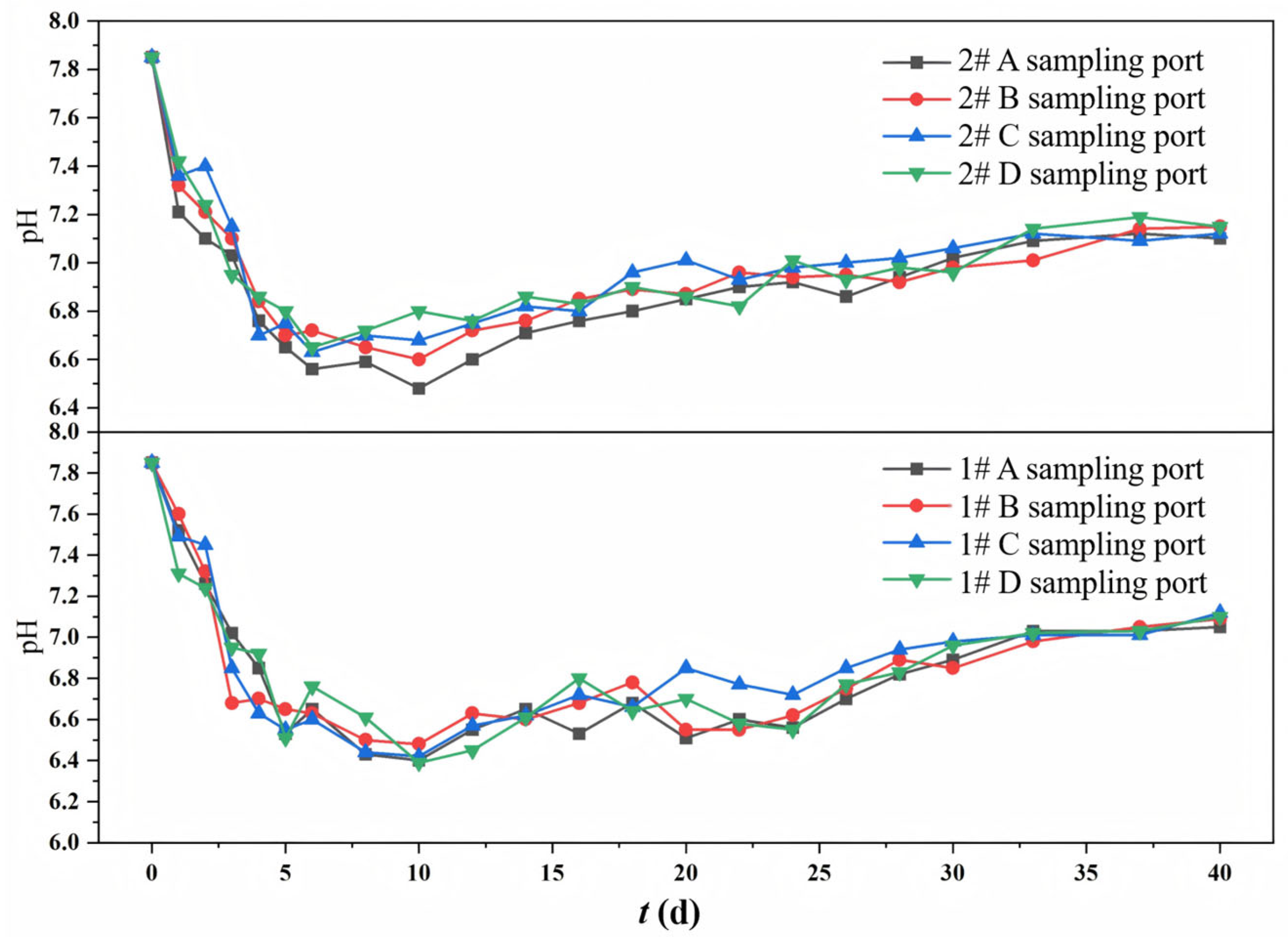
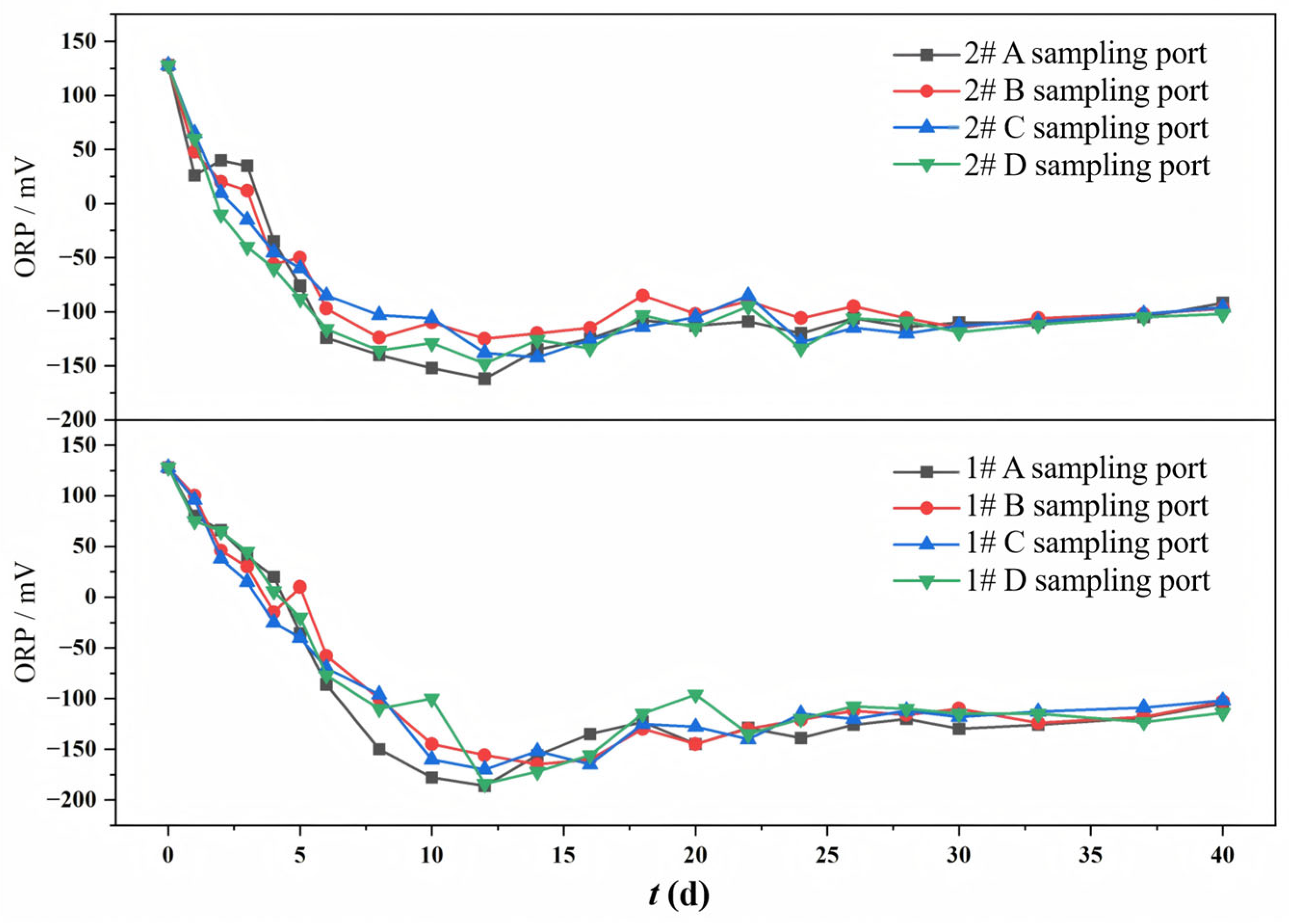
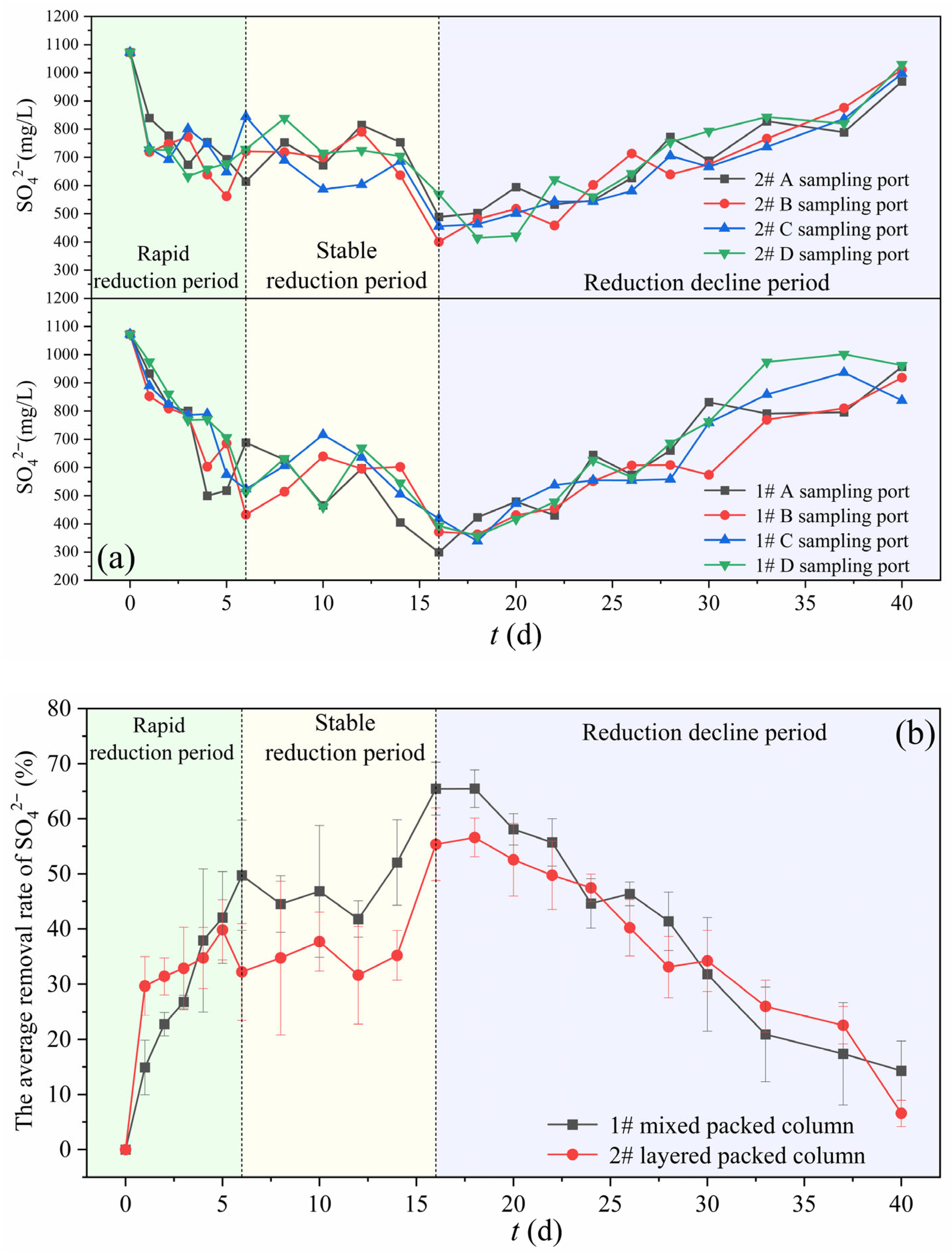
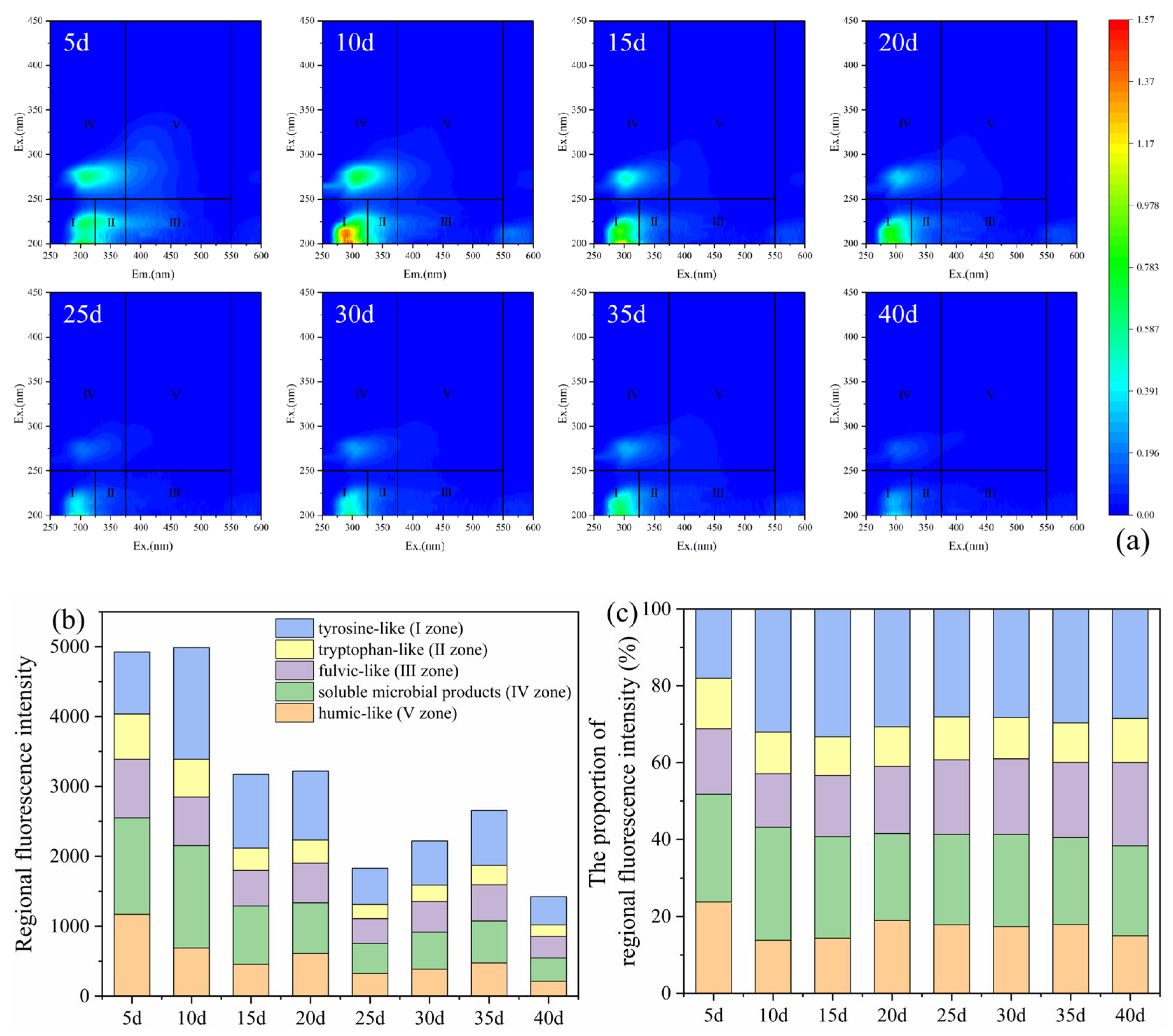
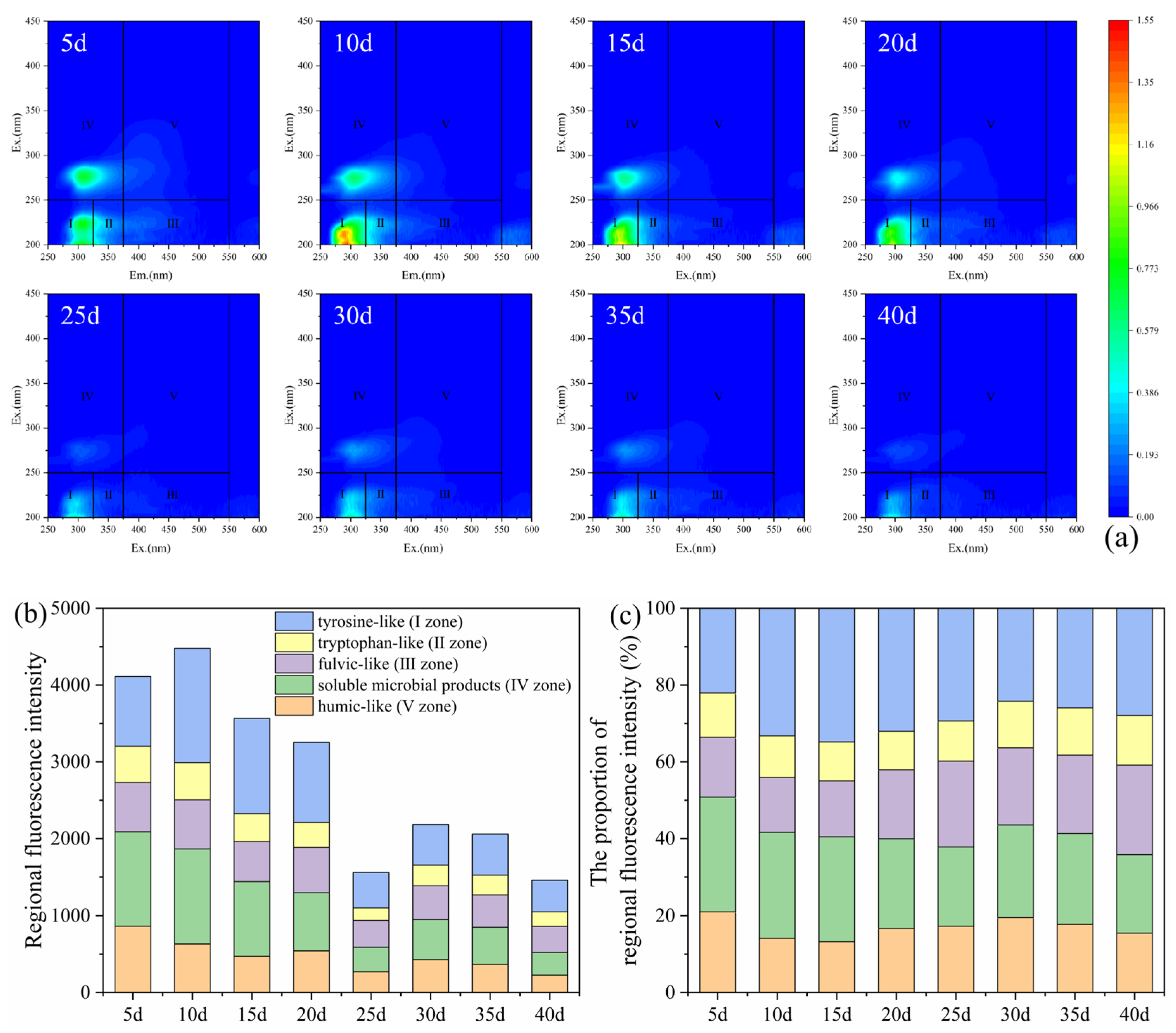
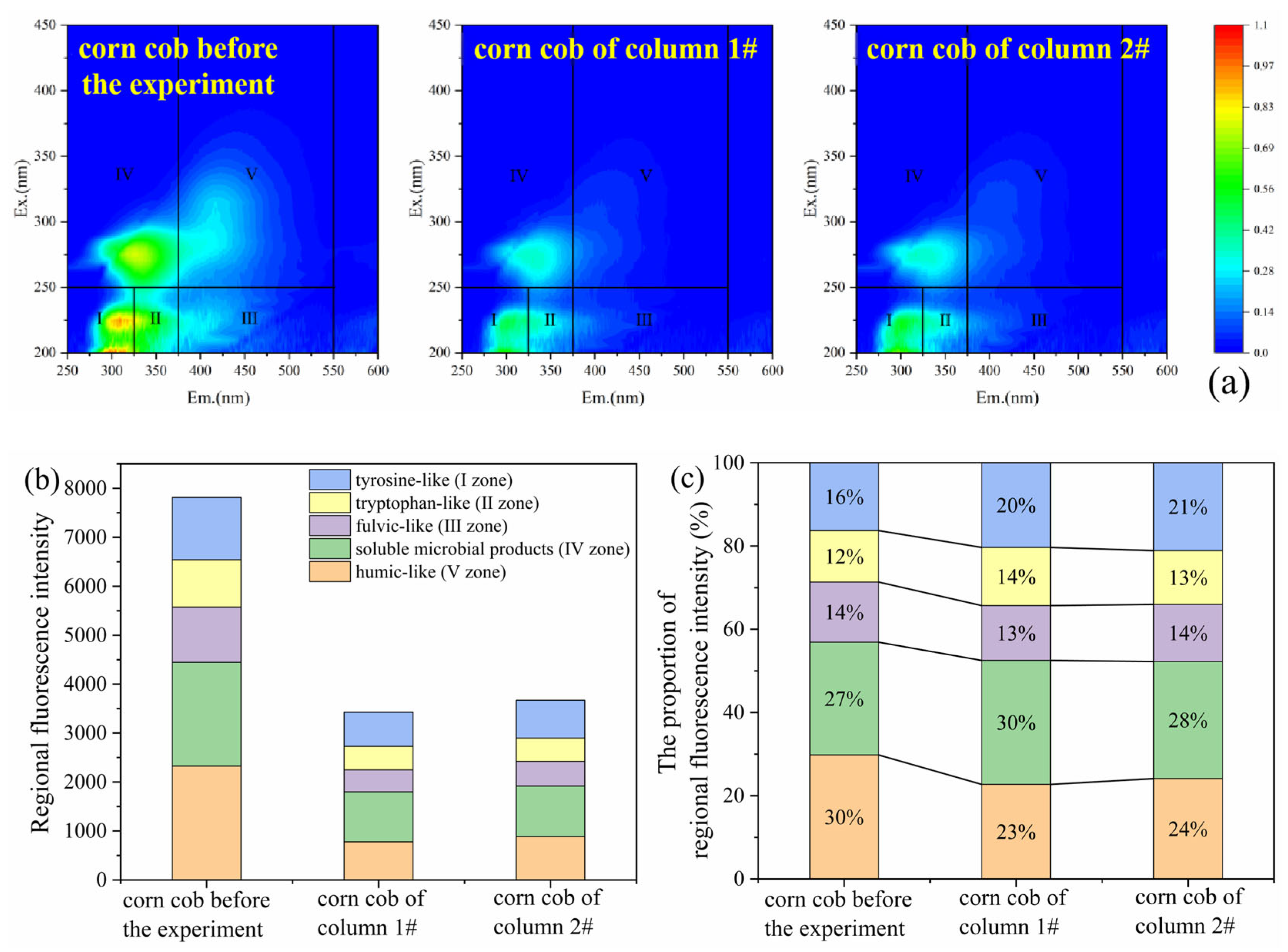
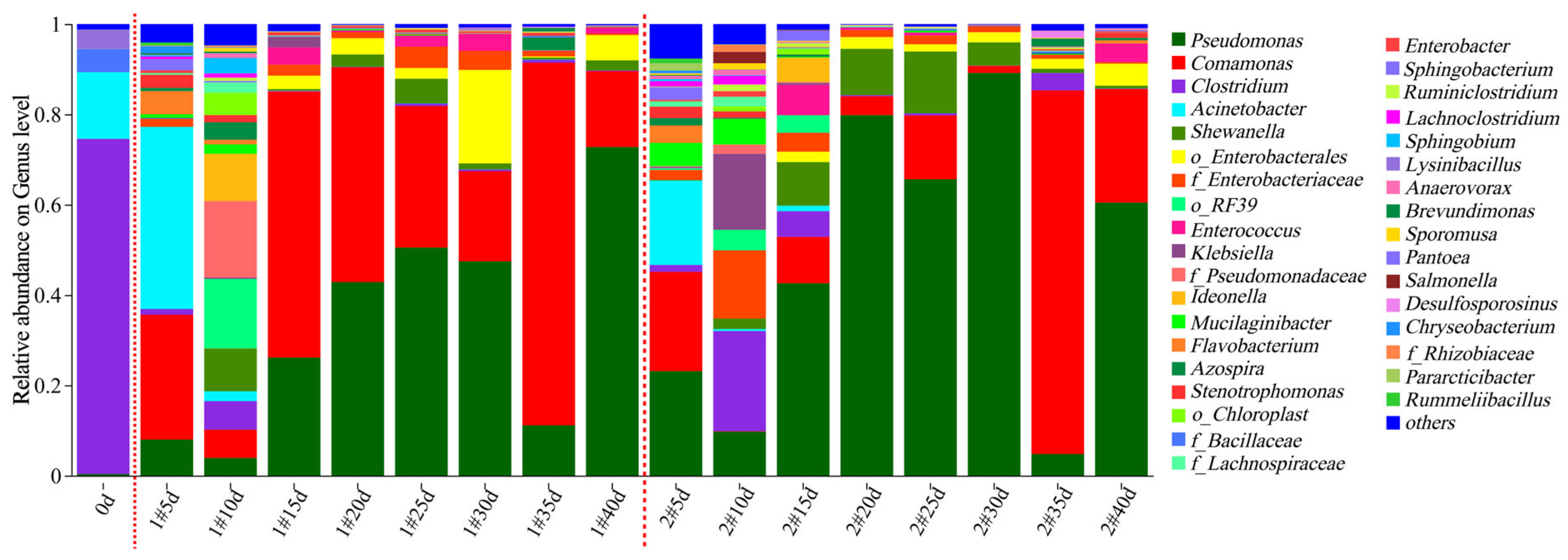


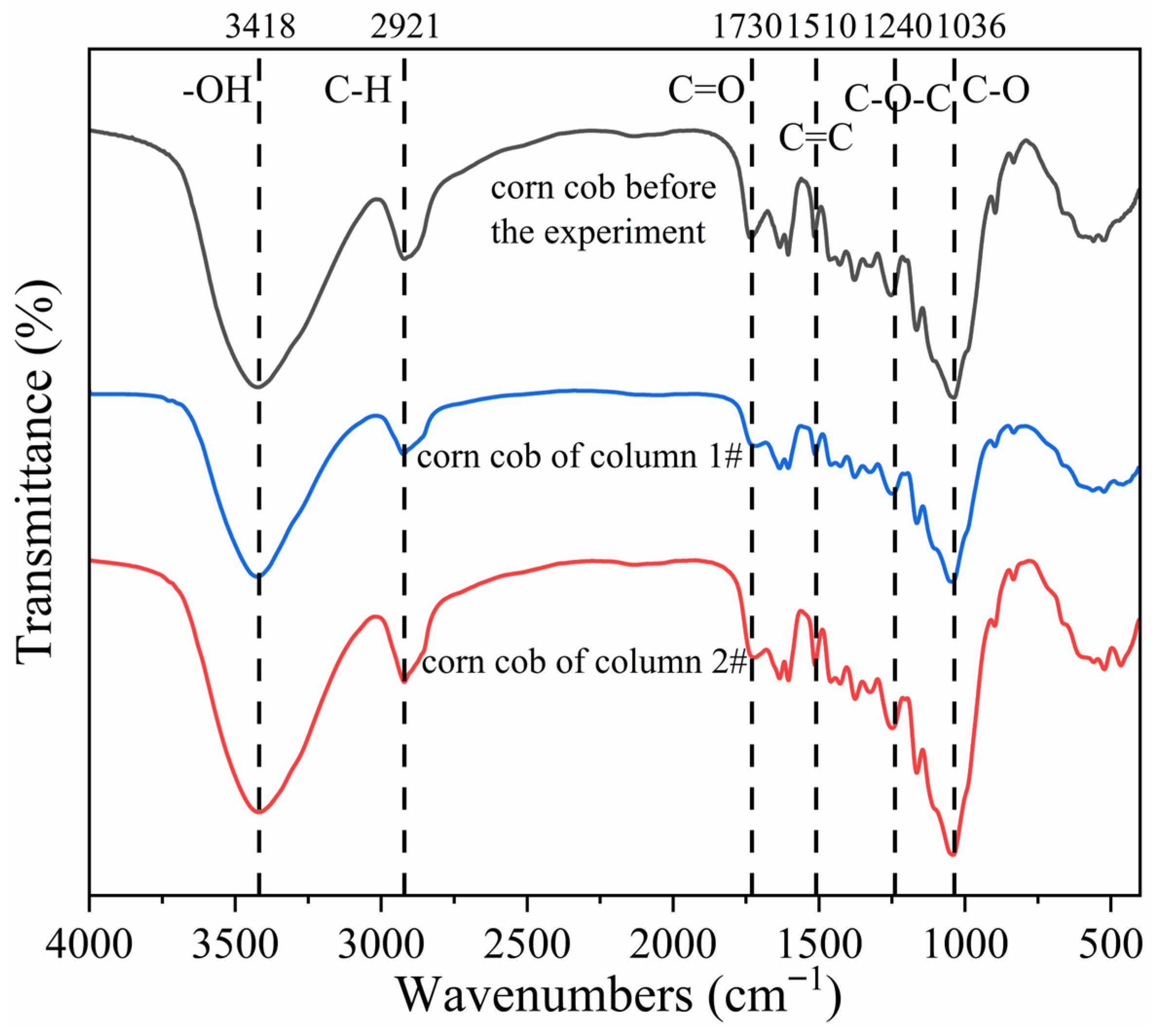
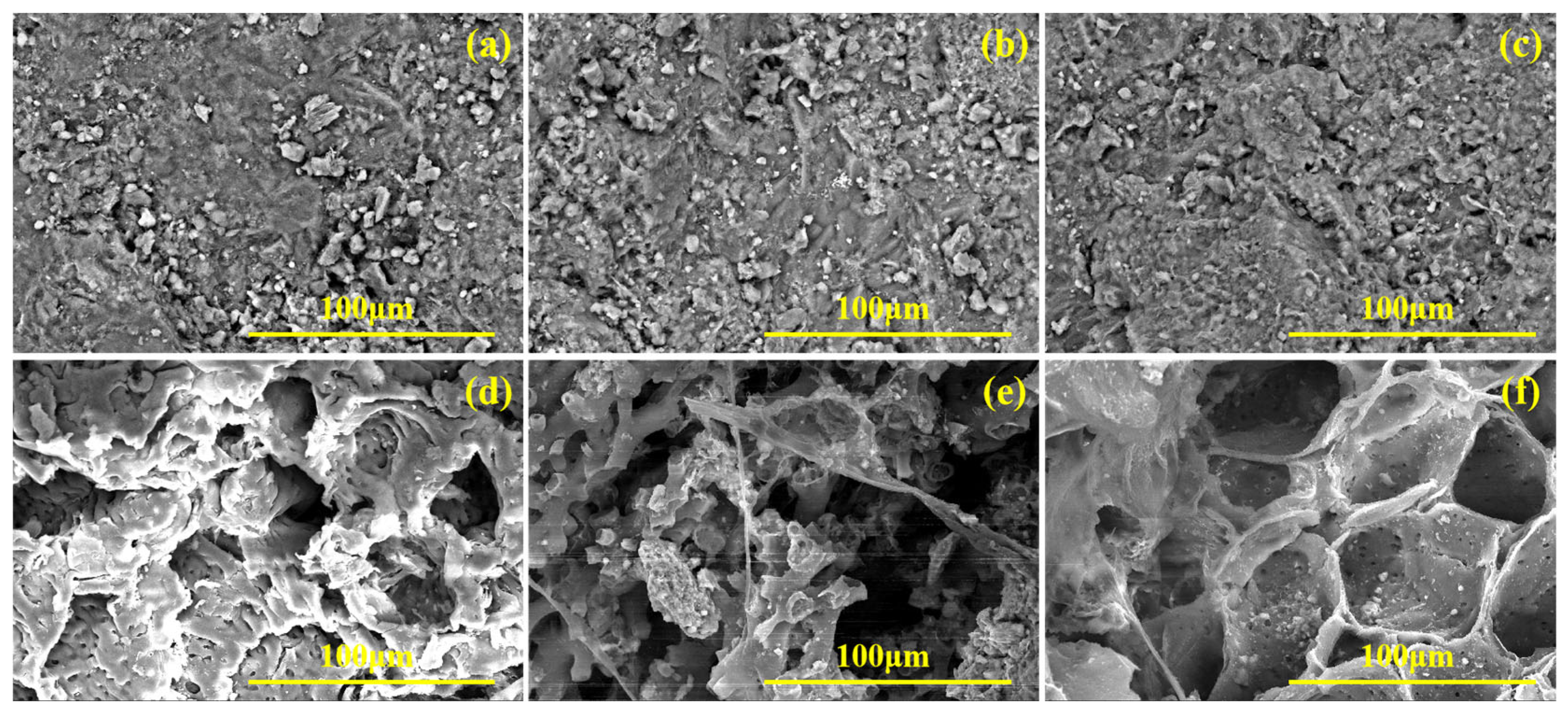
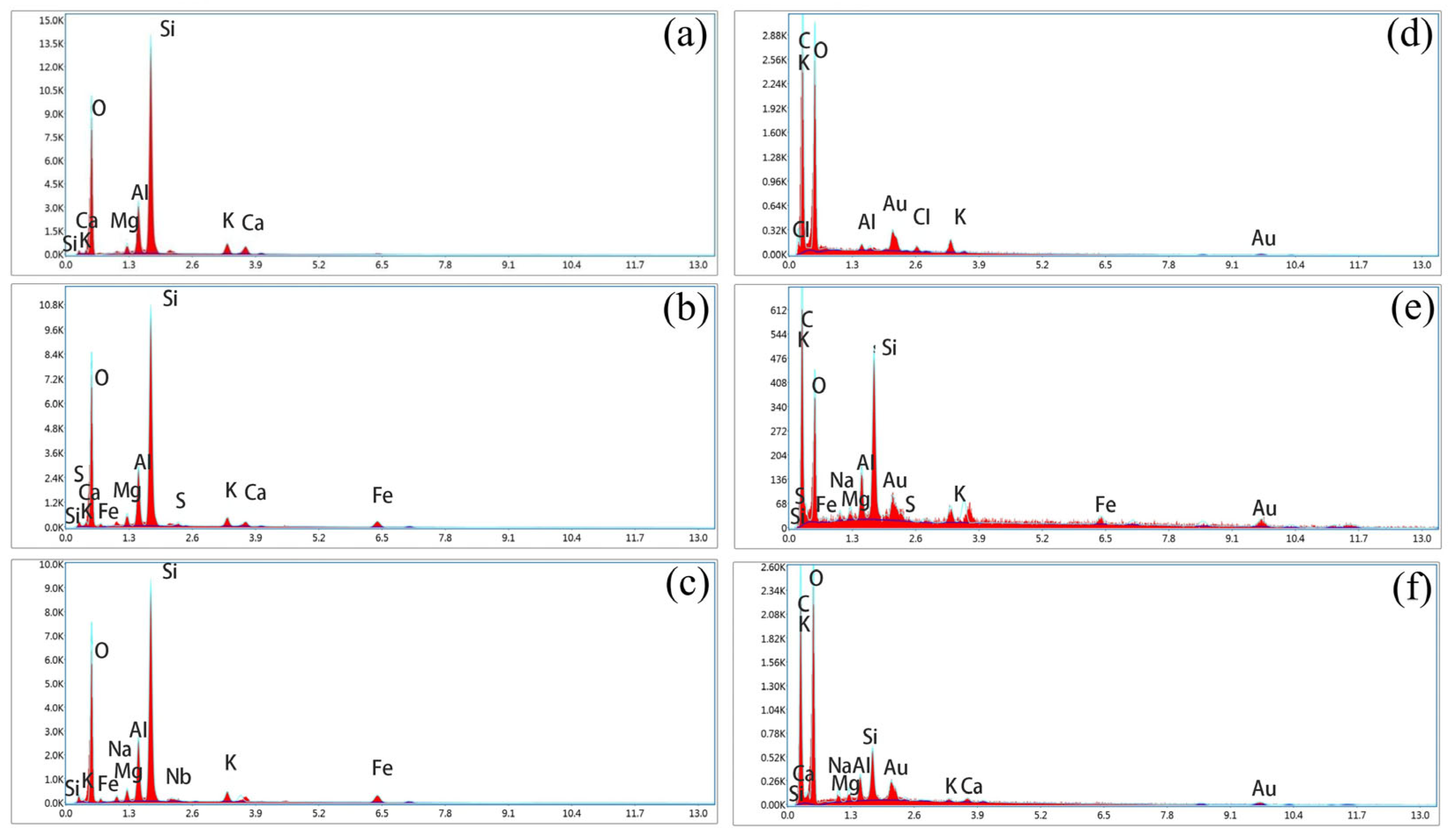
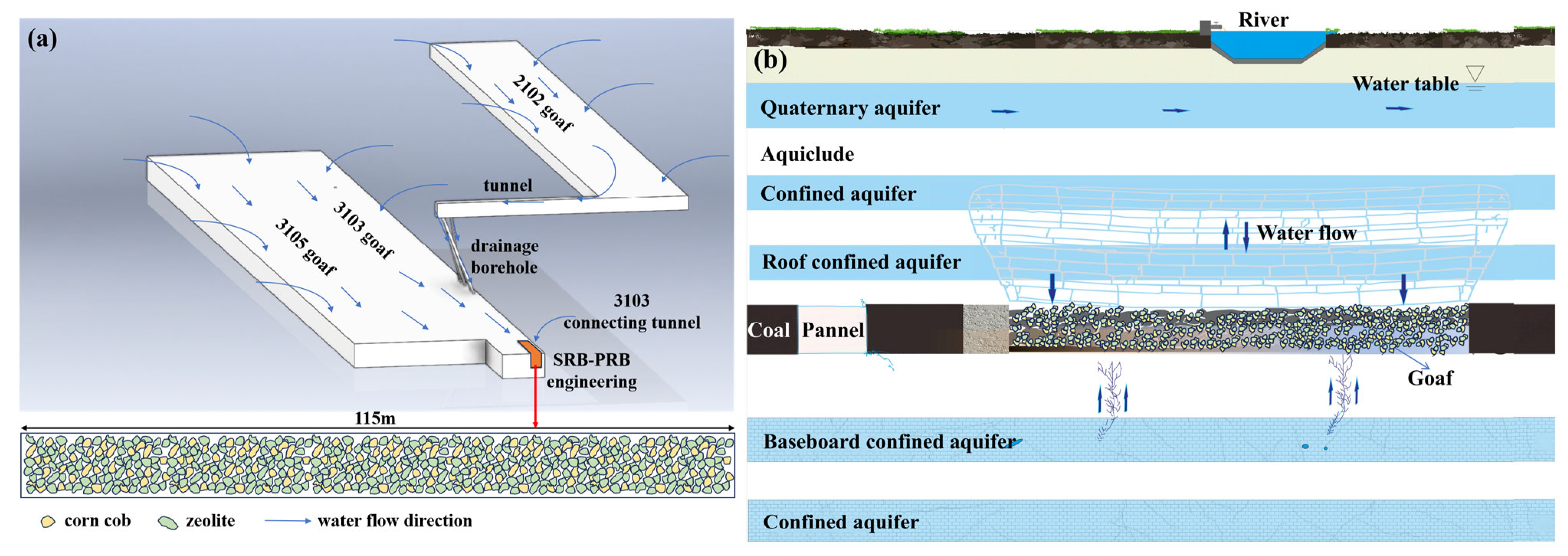
| Hydrochemical Components | K+ | Na+ | Ca2+ | Mg2+ | Cl− | SO42− | HCO3− | pH |
|---|---|---|---|---|---|---|---|---|
| Concentration (mg/L) | 4.19 | 676.96 | 66.47 | 11.08 | 167.12 | 1027.45 | 467.38 | 7.85 |
| Wavenumbers (cm−1) | Transmittance (%) | Functional Groups | Attribution Components | ||
|---|---|---|---|---|---|
| Corn Cob Before the Experiment | Corn Cob of Column 1# | Corn Cob of Column 2# | |||
| 3418 | 63.58 | 73.64 | 64.29 | –OH stretching motion | cellulose, hemicellulose, moisture |
| 2921 | 81.74 | 91.01 | 82.77 | C–H stretching motion | cellulose, lignin |
| 1730 | 84.66 | 92.31 | 86.33 | C=O stretching motion | hemicellulose |
| 1510 | 85.48 | 91.11 | 86.15 | C=C in the aromatic ring motion | lignin |
| 1240 | 77.45 | 85.59 | 76.53 | C–O–C stretching motion | hemicellulose, lignin |
| 1036 | 62.09 | 73.13 | 58.42 | C–O stretching motion | cellulose, hemicellulose |
Disclaimer/Publisher’s Note: The statements, opinions and data contained in all publications are solely those of the individual author(s) and contributor(s) and not of MDPI and/or the editor(s). MDPI and/or the editor(s) disclaim responsibility for any injury to people or property resulting from any ideas, methods, instructions or products referred to in the content. |
© 2025 by the authors. Licensee MDPI, Basel, Switzerland. This article is an open access article distributed under the terms and conditions of the Creative Commons Attribution (CC BY) license (https://creativecommons.org/licenses/by/4.0/).
Share and Cite
Zhang, L.; Xu, Z.; Xiahou, M.; Gao, L.; Gao, Y.; Guo, J.; Li, C. Mechanisms of Sulfate In Situ Removal Using SRB-PRB Driven by Low-Cost Sustained-Release Carbon Source in Coal Mine Goafs: A Dynamic Column Experiment Study. Water 2025, 17, 2684. https://doi.org/10.3390/w17182684
Zhang L, Xu Z, Xiahou M, Gao L, Gao Y, Guo J, Li C. Mechanisms of Sulfate In Situ Removal Using SRB-PRB Driven by Low-Cost Sustained-Release Carbon Source in Coal Mine Goafs: A Dynamic Column Experiment Study. Water. 2025; 17(18):2684. https://doi.org/10.3390/w17182684
Chicago/Turabian StyleZhang, Li, Zhimin Xu, Mingan Xiahou, Liang Gao, Yating Gao, Juan Guo, and Chi Li. 2025. "Mechanisms of Sulfate In Situ Removal Using SRB-PRB Driven by Low-Cost Sustained-Release Carbon Source in Coal Mine Goafs: A Dynamic Column Experiment Study" Water 17, no. 18: 2684. https://doi.org/10.3390/w17182684
APA StyleZhang, L., Xu, Z., Xiahou, M., Gao, L., Gao, Y., Guo, J., & Li, C. (2025). Mechanisms of Sulfate In Situ Removal Using SRB-PRB Driven by Low-Cost Sustained-Release Carbon Source in Coal Mine Goafs: A Dynamic Column Experiment Study. Water, 17(18), 2684. https://doi.org/10.3390/w17182684









